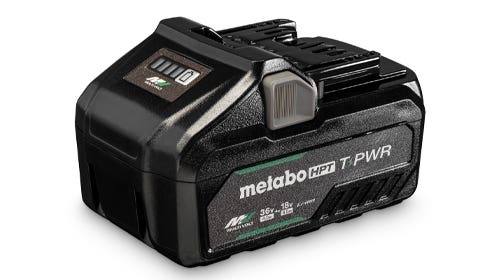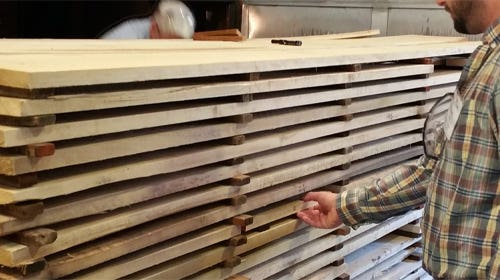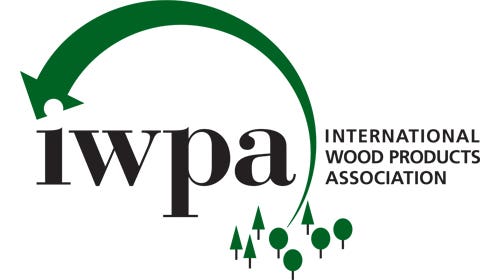Wherever you are, ebony will cost you perhaps $100/bf
There are several certainties about African ebony. First of all, it is hard, heavy and dense. What is also noticeable about the wood is its price – ebony is one…
There are several certainties about African ebony. First of all, it is hard, heavy and dense. What is also noticeable about the wood is its price - ebony is one of the most expensive woods in the world. Regularly priced between $75/bf and $100/bf, it makes one wonder why more people don't ebonize a significantly cheaper species with the use of aniline dye, stain or paint. But for wealthy customers, the real deal is the only deal.
{loadposition position10}
Ebony is one of the more familiar exotics, known for its black color, incredible hardness, heavy weight and amazingly high cost. Although the wood is often referred to as African ebony, there are many types of ebony from Africa, Southeast Asia, South America and Central America that possess different properties and color variations. Gabon ebony (Diospyros dendo), Madagascar ebony (Diospyros perrieri), and Macassar ebony (Diospyros celebica) are the most available ebonies sold in the United States.
Gabon ebony is often used as a generic term for black ebony or African ebony. It has jet-black heartwood with an occasional streak and comes from Gabon, Cameroon and Nigeria. The sapwood is a pinkish-white. Madagascar ebony (Diospyros perrieri), is primarily found on the western side of Madagascar and considered by many dealers to be the blackest of the Diospyros species. However, it has been severely overharvested.
Macassar ebony, also known as Indian ebony or golden ebony, comes from the Celebes Islands, Indonesia, New Guinea and the Philippines. Like other ebonies, the heartwood is black, but Macassar ebony is easily identified by its reddish-brown streaks.
Most exotic wood dealers will tell you that during the last 10 to 15 years, the quality of ebony has become an issue.
"I won't guarantee anybody pure black anymore," says Matt Westmoreland of World Timber Corp. in Hubert, N.C. "Somebody complained to me the other day that I sent the wrong kind of ebony. I said, 'Look, it is all African ebony, it all comes in the same supply.' But I said it is just like some trees. Some boards are blacker than others. It's the way it has always been."
"The [Diospyros] classifora is either from Cameroon or Nigeria," says Myles Gilmer of Gilmer Wood Co. in Portland, Ore. "That stuff comes out of the bush where they're cutting the trees down, all the sapwood off and in half so they have a roughed-out billet anywhere from 3" to 4" wide, up to 5' x 10', that gets carried out on someone's head. All the classifora has some color in it. I've milled some stuff that was jet-black, but 90 percent of it has some streaking in it. It is not objectionable and usually that disappears pretty quickly as it oxidizes. But I'll tell you what, the classifora mills so much better than just about any other type of ebony. God, its great stuff."
Ebony is used in furniture and cabinetry for inlay work, accents, pulls and knobs. Working with Gabon, Nigerian or Madagascar ebony is a challenge. The heartwood will dull almost any tool. Another difficulty with ebony is its tendency to crack or become brittle after the drying process.
"Ebony is used as an accent wood; usually very sparingly," says Mitch Talcove, owner of Tropical American Hardwoods of Latin America in Carlsbad, Calif. "It's also used as the premier fingerboard material. There are other materials that can be used as fingerboards, but traditionally bridges and fingerboards have been all ebony - not only for guitars, but also violins. When you spend $20 on a fingerboard and it is going on a guitar that is $3,000 to $5,000, it is nominal.
"The darker and less streaking [ebony has], the tighter the figure, the more valuable it is. They found objects in tombs in Egypt that were made of ebony so it has always been a very prized wood."
"Most people that come in the store and buy ebony, for whatever their purpose, they want genuine ebony," says Steven King of All Righteous Woods in Rowley, Mass. "But I would say that most of them are using it for inlay. We don't sell a heck of a lot; it's too expensive. Plus it is too hard to get in decent sizes. It just keeps getting smaller and smaller."
"It probably weighs about 5 lbs. per the board foot," adds Gilmer. "So on a retail basis, you're probably looking at $50 plus whatever it costs you to mill and ship it. Typically for lumber, it is $60 to $80/bf; for instrument parts, it goes up to $90/bf."
This article originally appeared in the October 2010 issue.






